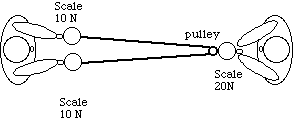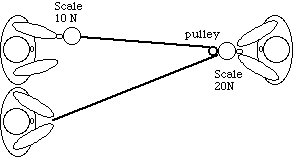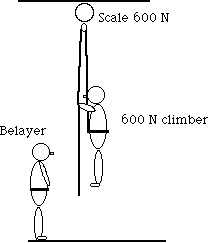
Two people sit on rolling chairs. One person on the right holds a scale connected to a pulley.
The person on the left holds two scales attached to the ends of the cord.
The forces in a climbing fall can be surprising
Material
To Do and Notice
Have the two people sit in two rolling chairs (or squat on two skateboards.)
Have one seated person hold on to a pulley, a scale may be placed between the pulley and the person.
Have the second seated person hold on to the two ends of the cord. The cord runs over the pulley. One or both ends of the cords may be connected to scales.

Have the people put their feet on the floor so that they cannot move. Measure the forces on the ends of the rope and on the pulley. Have the people raise their feet and notice that they accelerate toward each other.
Notice in my example that each end of the string exerts a force of 10 N on the person on the left holding the ends. A string under tension of 10 N exerts a 10 N force on anything attached to its ends.
The string wraps around the pulley exerting 10 N on each side of the pulley. The total force on the pulley is 20 N.
Now hand one of the ends of the string to a third person standing on the floor.

Both people in the chairs put their feet down and
hold their position.
The third person pulls on the end of the string, until the reading on
the left person's scale is 10 N.
The force on the right person's scale is 20 N.
If the left person raises his feet he accelerates with a force of 10 N.
If the right person raises his feet he accelerates with a force of 20 N.
So What ?
This is a matter of life or death in rock climbing.
If a climber falls, a rope running through a carabiner to his belayer stops his fall.
The carabiner is somewhat like a pulley.
The force on the carabiner is double the force on the climber.
So if a 600 N (150 lb.) climber hangs from a rope running through a carabiner to a belayer, the force on the carabiner by the rope is 1200 N (300 lb.).

A most interesting thing happens if the belayer hands his end of the rope to the climber, The force on the ceiling immediately drops to half. The force on the ceiling drops to 600 N.

What's Going On?
When the belayer holds the rope, one end of the rope must support the climber, the force on the climber will be his entire 600 N weight. The tension in the rope is 600 N. The rope passes over the carabiner attached to the ceiling, two ropes head down from the carabiner, the force on the carabiner is double the tension in the rope, or 1200 N.
When the climber holds herself up the tension in the rope must be 300 N. The total force by the rope on the climber is 600 N and it is exerted by two ropes. So each rope will exert half the total force, 300 N each. Two ropes also pass through the carabiner exerting two times the rope tension of 300 N on the carabiner, for a total of 600 N.
It is much worse in reality.
Usually the belayer stops a climber after she has fallen a distance. If the falling climber falls 10 meters and the belayer strops the climber in 1 meter then the belayer must decelerate the climber at 10 g's. The climber accelerates down under gravity at 1 g for 10 total meters and decelerates at 10 g's for 1 meter. The total maximum force is 11 times the weight of the climber, 10 g's for deceleration plus 1 g for gravity making a total force of the rope on the climber of 6,600 N, the force on the carabiner is then twice this or 13,200 N over a ton!
|
Scientific Explorations with Paul Doherty |
|
4 October 2001 |